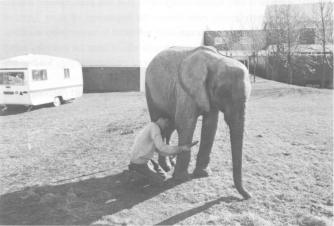
Chapter 6
Handling and training, is it cruel?
The first version of this chapter was published
in Animal Training (UFAW. 1990).
There is much ignorance and controversy concerning both
the handling and training of zoo and circus animals; if it should be
done at all, and if it is, how it should be done.
Before circus animals can be trained they need to be handled, or at least become familiar with human beings. Although handling is a type of training, and involves learning, there is a distinction. Training normally implies that the animal will learn to do something, whereas handling implies that the animal may well have to learn to do nothing (Figure 48). Handling animals is an area that has received very little attention to date. Serious consideration as to how even domestic animals are handled is rarely given, even though the beginnings of many types of behavioural problems for animals can often be related to inappropriate handling. Even very little handling can have considerable effects later; for example, only 5 minutes a day of handling for one week reduced problems of pigs loading and moving through new environments [87].
The first question is: Should wild animals be handled at all? (Although since there are poor grounds for making distinctions between domestic and wild animals in their treatment - see pages 154-160, this should encompass all animals.) Some have argued that wild animals in captivity should not be handled on grounds that this influences their behaviour and thus they are no longer natural. This is examined more fully later (see page 132). Some zoos take this line and are proud of their zero handling facilities. It seems extraordinary that such people appear to be unaware of the basic fallacy in their argument. If they take this view, how can they possibly justify having animals in captivity at all? After all, it is definitely going to affect their behaviour in one way or another; for example, the animals will become accustomed to humans looking at them when they are on view and learn not to run away, thus they are not behaving naturally (as they would in the wild).
If we argue that (given certain provisos) having and keeping domestic and wild animals in captivity is not of its nature wrong (see Chapters 8 and 9), what are the advantages of handling the animals?
First, what is handling? It is defined here as humans interacting with animals by touching, talking to, and being close to them over a period of time. The object of handling is fundamentally to reduce the fear that the animals may have of such close contact with humans and subsequently other unfamiliar objects. Once the animal can be handled easily and shows no sign of fear, as a rule both he and the human handler have begun to establish an emotional relationship, which if it progresses appropriately can develop into affection and pleasure in each others company. In addition, mutual levels of confidence with each other can build up to a point where the animal has confidence in his handler and will therefore go places and do things with her that he would otherwise be frightened to do.
Fig. 48. A young African elephant being handled in order to groom her.
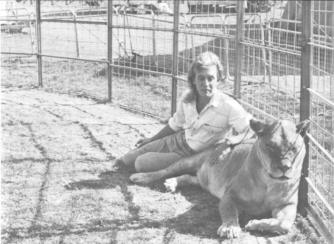
Fig. 49. A handler/trainer and a lioness. Positive (pleasant) emotional relationships between the species must grow if training is to continue to be successful and a pleasant experience for both.
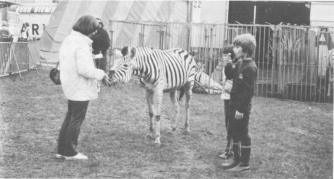
Fig. 50. Animals that have been correctly handled may thereafter seek contact with humans. Here a zebra contacts a mernber of the public.
Good handlers can achieve much with animals. They can often achieve a great deal more with a previously badly handled animal than the animals more familiar owner or keeper. It is not therefore only familiarity with the individual that is important, although this helps.
Good handling remains almost in the realms of the occult where horse handling, for example, was firmly placed by the secret society of horsemen and Whisperers in the eighteenth century. It was said that certain individuals could go quietly into the stable with a killing stallion and walk out with him quiet and gentle in half an hour.
How could this be without the intervention of strange potions, or spirits? Even today people marvel, and often with good cause, at others who are more able to handle horses and can achieve what, to the uninitiated, are often astounding results (e.g. Teddington-Jones, masseur for the US Long-distance Equestrian team, who gave a demonstration at Equitana Exhibition, Essen, Germany in 1988; Monty Roberts demonstrations, Stoneleigh 1983).
Handling involves understanding the animals body language, but also being able to control ones own so that it does not portray certain emotions that one might be feeling, for example, fear. Good handling must leave the animal with a pleasurable experience, otherwise the animal will quickly learn not to be handled. It is not difficult to teach most interested humans the first steps in good handling of animals, but how this develops with experience in that human depends on their interest, sensitivity and skills.
A key feature of good handling is that the animals and humans must have mutual respect. Insufficient respect for the animal and insufficient sensitivity of the human may result in the animal becoming more frightened of humans, and sometimes attack in defensive threat. Insufficient respect of the human by the animal will result in the human being completely manipulated by the animal and, as a result, the animal may become aggressive when it does not get its way, or simply bad mannered, pushing, pulling, barging, and generally ignoring the humans desires [88]. Bad handling may cause individuals to become more frightened of humans, aggressive or simply to ignore humans.
As a general rule, most good trainers are also good handlers, although the reverse does not necessarily hold.
The first, and most obvious advantage is that animals have to be moved around from time to time. If the animal can be handled and has learnt to be led or moved without panic and trauma, this will be easier for the human managers. It will also be easier on the animal since he will not have to suffer the traumas of being drugged by immobilisers and its accompanying risks and the fear of new sudden and unexpected closeness to humans, being manipulated by them, and all the other unfamiliar and potentially frightening things that might happen at such times. It will also cut down the risk of injury to the animal that might be inflicted on him by the drug use, or that he might inflict on himself by panicking.
The next advantage in having an animal easy to handle is that routine veterinary care can be done without drugging, panicking the animal under physical restraint and so on, whether this is the injection of cat flu vaccine, examination and treatment of wounds or administration of normal prophylactic medicines. Captive wild animals in zoos can often only be treated by being first darted with immoblisers, or by being physically restrained with ropes, and so on (see page 61 and Figure 20).
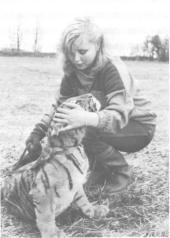
Fig. 51. A young tiger who has been hand reared out for a walk with her rearer and emotional companion.
Everyday management of the animals is easier if good relaxed relationships between the human stockpeople and the animals are the result of good handling. Elephants can have their feet cut in the circus compound while the everyday routine goes on around them; a young tiger can be taken for walks to become accustomed to moving around new and different objects (Figure 51). The animals can be moved about and there is a noted lack of tension in the air. By contrast, a zoo trying to transport elephants which are unfamiliar to being handled has to chain the elephants to a tractor with the chain running through the transporter in order to restrain them and get them to load. In addition several people, often all somewhat frightened and excited, must be around to lift and pull objects, and the operation may take hours to complete.
It is, I suggest, unacceptable that animals in zoos must be injected with immobiliser in order to have routine treatments, e.g. a zebra having its feet trimmed, an operation which thousands of horses and ponies, and zebras in circuses have done regularly with no drug treatment.
Handling also has positive attributes in terms of the education of human beings. By being allowed to touch and handle animals, as they often can in the circuses (Figure 50), humans who may never have had an opportunity of being so close to a large animal before are able to experience their feel, touch, warmth and relate to them as other sentient and intelligent individuals. Most people who are interested enough in animals to go to a zoo or circus, will want to get very close, to touch and to interact with the animals. This is why zoos have such a problem with people feeding their animals, and why they often introduce petting corners where there are a few domestic animals that can be touched.
In the circus, the animals have come to a normally human dominated area: the town - not the people to the animals as in the zoo. In addition, there is a certain informality about the tented encampment and trailers, people and animals wandering round about. These factors encourage the public to approach and watch the routine husbandry of the animals and indeed to touch and handle them where permitted. A camel was tethered and I counted that 200 people in one hour came up to her, not just to pass by as is often the case in the zoo, but to touch her and look into her eyes, and have her respond to them. When I told the circus proprietor that I had done this count, her immediate response was: Poor camel, we must stop this! However, it is clear that the animal herself can also have some say in how much is enough. If the animal finds so much attention excessive, she can always show it, by for example nipping or threatening, as many ponies do in similar circumstances. In which case, the animal will no longer be tethered where the public can touch it!
Handling, then, can allow individual humans to relate individually to animals, become more familiar with them and learn to respect them more, as well as being imperative for reducing traumas, discomfort, pain and fear and the need for using surgery, drugs or restraint for management. One could say that, ideally at least, all capture bred animals which are not going to be repatriated to the wild in urban zoos and circuses must be handled by their keepers and trainers. If keepers and trainers cannot do this, then perhaps they should change their job!
Many are now beginning to accept that the handling of wild animals in captivity is often beneficial to their welfare [e.g. 84]. In addition, it can engender a greater respect in humans for the animals. However many still argue against the training of animals. This is an area for debate, and like many other aspects of our treatment of animals, it has been subject to much partial and woolly thinking. Some of the reasons why the training of circus animals particularly comes under attack are:
a) because they are wild animals which are very unfamiliar and often frightening to human beings, even to those who are very familiar with domestic animals (this argument is considered in Chapter 7);
b) because they are trained to do elaborate, and sometimes remarkable and astonishing things. The public, again even those experienced with everyday animal training often cannot believe that this is possible without using cruel methods. It is almost a situation where the observer feels they could not do it, so how could anyone else?
Take one simple example. In training the ungulates (hoofed mammals) the first thing that the animals are taught after learning to lead, is to come to the centre of the ring when their name is called. First they are led in, and then they are called by name and led to the centre where they are given both a food and a voice reward. When this has been well learnt, they will then do it at liberty, coming into the centre when their name is called. It is a remarkable sight to see 12 young 2/3-year- old Arab stallions trotting around at liberty, and when the name of one is whispered, that horse only swirls into the centre. How many horse owners bother to teach their horse to come when called always, not only when he is hungry? Let alone perform at liberty? Such behaviour is circus and frowned on by the majority of the horse establishment; it is almost in the realms of the occult!
Despite the above, the accusations directed at the training of circus animals should be investigated properly. These can be placed into six groups:
1) Circus training inevitably involves cruelty. This can involve physical restraint, goads and whips, and even electric shock and burning. B. F. Skinner (backed by the money, equipment and approval of the scientific establishment) used shock and pain to condition animals. This scientific approach has been enormously influential among behavioural scientists and the lay public; as a result, it is widely believed that the development of Conditioned Responses by Negative Reinforcement is one of the most important ways in which animals learn. Is this really the case in animal training?
2) Training consists of dominating the animal and serves only to enhance the anthropocentric belief in humans superiority. This results again in humans having less respect for the performing animal, and more for the presenter or trainer.
3) There is a loss of dignity in performing animals.
4) Training is essentially unnatural. Animals should only learn what is natural behaviour.
5) Wild animals should have special status. It may be appropriate to train domestic animals, but not wild ones (Chapter 7).
6) Nothing can be learnt about animals from circuses. They cannot contribute to conservation, research or human or animal education therefore any entertainment value is essentially worthless (Chapter 7 again).
The general husbandry of the circus animals, as we have seen, was sometimes tradition bound and (although improving) would benefit from further updating. This is true of almost every type of animal management system, from farming to kennels, horse racing stables to zoos. However, it is only in circuses that wild animals are trained, and where there is any serious attempt at forming emotional or working relationships with those species not normally in close association with humans.
During my observations on training, it was clear that not all animals found learning all the tricks easy, or all trainers found the training easy. Inevitably, some individuals became somewhat anxious before they were asked to do difficult things, or when they did not understand what was required.
In this brief review, we will first look at evidence for and against the arguments 1 to 4 above.
1 2) Circus training inevitably involves cruelty
Cruelty is defined here as activities that cause unneccessary, severe or prolonged distress and anxiety.
Some of the acts or tricks that circus animals perform are elaborate and apparently difficult for the animals: an elephant balancing on a revolving ball, a bear dancing on his hind legs, a lion jumping through flaming hoops. The average member of the public cannot visualise how the trainer can possibly train the animals to perform such acts without using extreme coercion, including such things as tying animals up with ropes and other forms of physical restraint, or electric shocks, thrashing with whips, and so on.
There are poor and bad trainers, and such things have, no doubt, gone on in some places. But to what extent are such methods used today in British circuses, and in particular are they essential? Or is it possible to train animals to do such things without cruel methods, and if so what methods can be or are being employed?
There are various considerations and we must discuss techniques in relation to animal training. These are:
a) physical or chemical restraint
b) word command
c) anxiety or distress exhibited by animals during training
d) the use of negative reinforcement to make the animal act - or the use of punishment after the act or lack of it
e) the use of the whip and human dominance
f) the use of positive reinforcement (reward) and evidence for pleasure in training.
We will look at how each of these is used in circus training.
Physical restraint - such as ropes, lead reins and side reins - were used in the initial training of all the hoofed stock (Figures 52, 54). The carnivores were trained loose, diversionary tactics being used in the case of a dangerous situation (a second person was often in the ring with the young animals). The elephants were also trained loose - an elephant hook was carried, however, by most of the handlers and trainers. The hook used behind the animals ear can obviously be an unpleasant stimulus, but I saw no evidence that it caused any wound.
No twitches or hobbling of animals, such as is recommended practice in veterinary ethology textbooks for hoofed stock [cf. 44] were used while I was there, and I saw no evidence that they ever were. Also, I found no evidence that any chemical restraint - such as tranquillisers, sedatives etc. - were used either during training or at any time in the circus, although they are often recommended for the management of zoo animals.
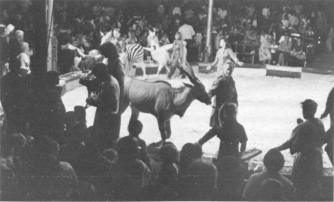
Fig. 52. The hoofed stock being led round the ring.
Initially, lead reins and lunge reins were used to lead the hoofed animals around the ring, whip positioning and body postures were used to encourage the animals to stand on the ring edge and on pedestals. Ropes were used to hold a leg up when encouraging a horse to bow, to do the Spanish walk (exaggerated front leg action), to encourage the camels to kneel, and so on. Some animals did fight the restraining ropes and leap about: for example, the camels and some horses when learning to kneel and lie down. In some cases, the use of ropes was unnecessarily rough.
As a general rule, there was more than one human to each animal in the training sessions, and the animals would be walked through the routines by the human helpers. If the animal was particularly uncooperative, such as a young zebu bull which tended to be aggressive, and a zebra stallion which tended to leap about, then two helpers were used to lead the animal (Figure 53), the emphasis being on calming the animal, rather than exciting it with whips.
The next step is for the animals to perform the routine off the lunge. This took weeks, sometimes months of training.
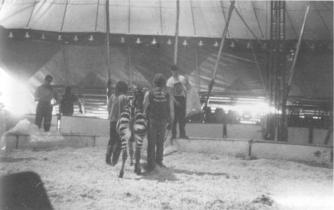
Fig. 53. A young zebra stallion in a training session, getting to know the ring, the lights, staff rnoving around, scattering sawdust etc. This stallion was led by two people to ensure cooperation.
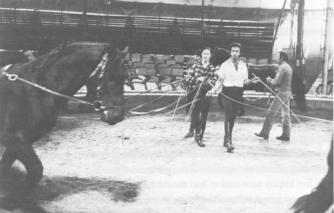
Fig. 54. Training of a liberty horse act starts with individuals on lunges.
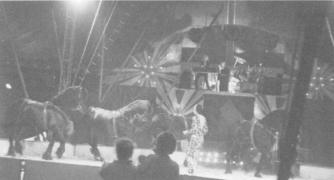
Fig. 55. It gradually develops until the horses respond to the body position and posture and position of the whip of the presenter.
One thing that seems to be important is that the amount of physical restraint used to make animals do things is inversely proportional to the skill and relaxation of the trainer. For example, a young nine-foot Reticulated giraffe was bought in to walk around the ring for the first time when I was watching a training session. This was a large, strong and slightly anxious animal which was led by a head collar and lead rope. At any time the animal could have run off, trampling everything and everyone around. The trainer simply walked calmly in front of him, talking to him and giving him small rewards; in this way, apparently instilling confidence and goodwill to the animal so that he did what was required by choice... walked quietly around the ring, keeping close to his familiar handler.
In animals that had previously worked in the circus and particularly those that had been trained by the same trainer, word of mouth was used to ask for a different activity; for example, elephants learning a routine involving holding a person in their trunks, were simply told to pick him up and hold (fig56). Horses which had performed before were told to go a deux or a trois when and where required, and would obeythe word command.
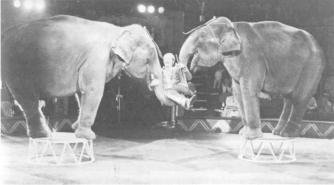
Fig. 56. Two elephants holding their trainer in their trunks as a result of word commands only.
In the normal use and association
with humans, very few animals, with the exception of dogs, are taught to respond
properly to their names. By contrast in the circus training, the first thing
that all the liberty animals (elephants, horses, ponies, zebras, eland, llamas,
camels, goats and pigs) were taught after they had become familiar with the
ring and being led around it, was to come to the centre when their own name
was called.
As the training advanced, so more and more words were understood by the animals, although some species were better at this than others. It was taken for granted that the elephants, for their day-to-day management, understood round about 50 word commands; their name, stand still, lie down, lift different legs etc. They also understood concepts such as left and right. The animals were also scolded by word of mouth when they did the wrong thing, and if this did not have the required response, it was backed up with a repositioning of the whip, or the animal might even be touched with the whip. They were also praised frequently when they did the right thing, and sometimes rewarded with tit-bits. It was particularly interesting how frequently verbal praise was used by the trainers, and how effective it was.
Once the animal has learnt what Yes and No signify, it is a great deal easier for him to understand what is required thereafter. If a proper training schedule is continued, it is axiomatic that the animal accumulates an understanding of many more word commands. This is rarely done with domestic animals - only a few necessary word commands are taught, after that particularly with the larger animals, physical restraint, pushing or pulling, leading, tying and holding are used instead. The animals are not expected to understand the words and thus they do not learn them.
c) Anxiety or distress exhibited by animals during training
There was no evidence of prolonged or acute distress, or high levels of fear or anxiety during the training of any of the circus animals that I witnessed in the 200 animal hours I watched training. There were occasions when the trainers became short-tempered, but even then their use of the whip and administration of punishment was restrained. It was probable that the trainers were being restrained because of my presence, but allowing for that it is not possible to describe any of the training that I witnessed as very distressing for the animal, as judged by the animals behaviour.
Some of the young animals were frightened initially of the new experience of coming into the ring; for example, the young cats, and a young giraffe. The former, because they were anxious, were left in the ring daily for hours at a time so that they became used to the ring before any serious training was begun. Behavioural indices of when this had been achieved were used by the trainers. One of these was if the cats were playing together; another if they were relaxed enough to sleep.
Two llamas spat during training sessions, and two camels salivated profusely and leapt around growling - possibly signs of anxiety. Some animals certainly showed behavioural evidence of frustration and approach avoidance conflict from time to time (head shaking and tossing, tail swishing, yawning, lip licking, and staring away) and some refused to perform certain acts, such as the goats climbing up on to a plank over some cattle (figure 59), or one camel refusing to kneel down.
d) The use of negative reinforcement
It is widely believed that animals can only be trained to do the sorts of things they do in circuses by the wide use of negative reinforcement, that is being forced to do the action by having some unpleasant thing done to them if they dont do it. The perennial example given of this approach is: how could bears learn to stand up and dance except by placing them on a heated plate so that their feet burn and they lift them? This suggestion may be appropriate for the Skinnerian scientist in the laboratory, but for the circus trainer, apart from any other considerations, it is rather impractical! This is particularly so if there are easier, simpler and much less risky ways of teaching such a behaviour, which there are of course. The burning feet approach has other disadvantages which the circus trainer who must live and work with the animals thereafter is unlikely to ignore; for example, a hurting bear will be a frightened and/or aggressive bear who may attack in defensive threat. Hurting the bear may also damage relationships between trainer and bear irreparably. This is an important factor as the trainer will find it impossible, or at the least very expensive, to obtain another bear. The trainer looks forward to working with this animal for many years. It is also possible that the trainer does this job because of a strong interest in animals, and in particular the bear. The trainer may also be fond of his bear. This sort of behaviour which is likely to scar the relationship will often make the trainers job more difficult, because the animal becomes frightened and aggressive. Any knowledge of learning and learning theory points out how inappropriate and self-defeating the approach of training by using severe negative reinforcement may be.
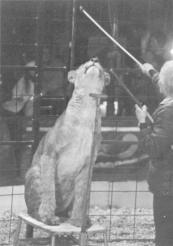
Fig. 57. A young lioness learning to stand up on her hind legs by positive reinforcement: reward of a piece of meat on a stick. She learns to go to the stick, and receives her reward.
Circus animals have to be handled and moved around daily, and although negative reinforcement can be used successfully to train isolated animals in Skinner boxes, or could be used possibly to train small animals which can be easily restrained, it is very inadvisable to use such techniques for large, possibly dangerous animals. The reason is that it is when animals are scared and hurt that they attack in defensive threat, or flee. Thus the use of fear and pain to train large carnivores is selected against. Trainers who use these techniques get eaten! Frightened elephants are also something to be avoided, particularly if they are in collapsible tents!
Frightened animals are dangerous, whether they are bears, bulls, dogs, horses, sheep, cats, elephants, llamas, camels, tigers, leopards, lions or jaguars. Thus one of the first lessons a trainer of large animals learns, if he or she is going to remain alive and retain all their appendages, is not to frighten the animals. The early training of the big cats that I witnessed with three different trainers concentrated initially in simply getting the animals used to being in the ring alone. Over a period of weeks the animals gradually become accustomed to the trainer (in one case this was a six-months pregnant woman) and perhaps a helper being in the ring cage with them while great care is taken not to frighten the animals. If this happens then the training must go back and repeat the previous learning steps. All the training of the big cats is based primarily on reducing levels of fear and on positive reinforcement: rewards of pieces of meat on sticks (Figures 57; 58). The humans word of mouth command, body position and the position of the two sticks or a whip are the cues for controlling the cats movements. Similarly, elephants will work for titbits. One of an elephant trainers greatest worries is sudden loud noises, or visual changes outside their control that might frighten the elephants; for example, dogs chasing them, or helicopters flying a few metres away. The answer to this problem, the trainers have discovered, is not to keep the animals away from all such stimuli, but rather to expose them to them so that they become used to them. Inevitably, even with the best trained, most experienced animals there are anxious moments like when the Royal helicopter landed a few feet away from one circuss elephants, and the "Royal emerged to smile sweetly at the elephants while the trainer sweated, but the elephants stood stock still!
It is widely believed that it is not possible to train animals at all without dominating them and showing who is boss. This is something I as a trainer have thought long and hard about. It is easy to accept the hypothesis of dominance hierarchies and apply it as an explanatory concept to all animal societies, but we are gradually realising that in many cases this is an oversimplification, and can lead up the garden path and even into the garden pond! In the first place, no one seems to mean the same thing by dominance. They vary from situation to situation, and sometimes are artefacts of behavioural disturbance [e.g. 1; 29; 96]. In fact, it is a misguided and overused term that is only useful very occasionally.
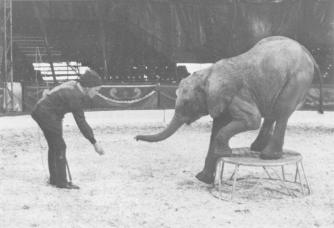
Fig.58. A young elephant following the trainers hand with a tit-bit in it, off the pedestal. Having achieved the right position, tne elephant is rewarded with the tit bit.
In practice, we often take dominance to mean showing who is boss. In training animals, is this necessary or indeed useful? In my experience this attitude, far from being helpful, is often positively harmful in educating either humans or animals. Suppose we rephrase it to be inculcating a basic moral sense, and showing mutual respect to the child/animal? In other words, teaching the adult, child or animal what type of behaviour is approved of and desirable by the teacher, parent, trainer or society at large, and what type of behaviour is not? This is what good teachers of children do.
Such a change in terminology immediately makes a difference in the attitude of the educator. Instead of the teacher requiring absolute obedience, and submission [cf. Federation dEquestre International and British Horse Society assessment of Dressage tests] from the student, he or she aims at cooperation and communication. The result is that correct behaviour is praised lavishly, and incorrect behaviour is disapproved of. The educators job is to present the problem, or the action, so that the student wants to do it. The problem to the educator is not one of disciplining and dominating, but one of motivating. Such an approach reduces or eliminates the need for punishment, which is difficult to apply correctly, and frequently causes rather than reduces problems. It encourages self-criticism on the part of the trainer/educator, and avoids confrontation of wills, and the concomitant high negative/emotional tension (i.e. temper losing, anger, fear and aggression). It opens up the possibility of using many of the ideas and techniques of educational psychology in animal training.
If one looks closely at good animal training, in the circus or anywhere else, from fleas to human beings to elephants, dominance and submission is a long way from what is actually going on. Interestingly enough it is not what the audience wants either apparently. The most popular acts are often those where the animal is apparently in control, such as the bucking donkey, or the trick dog who gets the better of her human partner.
Thus I argue that dominance is not a sine qua non of circus training. Although some basic moral education and motivation to learn for both animals and humans is.
As whips feature much in circuses, it is often considered that they are used not only indiscriminately in the training of the animals (it is rare to find people complaining that they are used severely in performance), but that they also serve to demonstrate the dominance of humans over the animals, and thus underline the anthropocentric idea of animals being demonstrably inferior to human beings.
Whether or not these are the reasons for the association of whips with circuses, it is certainly true that whips have a traditional place in circuses. It is also true to say that many circuses in Britain today are bound by tradition. Some are more concerned with history and keeping tradition going than developing a possible art form and educational medium for teaching people about animals. Circus people make whips, talk about whips and pride themselves on their whip craft. However this does not mean that they whip each other or their animals more than other people!
The whip has become one of their props, like the macho image of the lion tamer and his self-displaying garments. It is perhaps unfortunate and detracts from the potentially important attributes that the circus has.
The first questions then are: How is the whip used in the circus? Also, is it necessary for all presenters to carry whips, crack whips and generally play around with whips for the animals to perform?
In answer to the second question first, I asked a trainer and presenter of, among other things, a liberty horse act if he needed the whip? He said not and to prove it he presented the horses at the next performance with no whip and his hands in his pockets. The act was as good as ever, and he received excellent applause from the audience, although nothing had been announced to draw their attention to this. This demonstrates that it is not necessary always to present an act with a whip, either to ensure the animals perform properly, or to obtain the approval of the audience.
Animals in training, or new acts, may need the presenter to have a whip as the animals will be less skilled at picking up the cues. In the early training of any large animal, one of the first things that the animal learns is to go away from the whip. Thus it is the position of the whip relative to the animal that gives the cue. The whip is not there to whip the animals with, it is there rather to emphasise the message, like using flags to emphasise the arms when sending semaphore messages.
Circuses should move away from their traditional association with the whip, and progress as a rule (rather than as an exception) towards teaching animals to respond to the human arm position, or perhaps even the lift of an eyebrow, or a whistle. This would be more impressive, interesting and informative to the public and it would emphasise cooperation between performers and presenters rather than domination over the animals by the presenter.
Nevertheless, the whip is not usually used willfully or excessively in the circus. In fact, there is much more thoughtless and unnecessary whip usage at markets, on farms and in domestic animal training establishments, particularly among amateur trainers. If the whip is one of the reasons for disapproving and trying to ban circuses, current practices in horse training should also be looked at carefully.
The whip, it has been argued, is a symbol of human domination over animals, and this comes to its zenith in the circus. Even if this was once the case, it is again not a sine qua non. It does not mean that circuses necessarily have to demonstrate the domination of humans over animals.
The assumption that the most attractive thing about riding a horse, working a dog, or presenting a lion act is the feeling of domination over the animal is often stated. It is an interesting idea and one that must be considered carefully. It is possible that this is the reason why some people train animals, but I would suggest that many more like to work with animals for their own sake.
Another approach is to consider cooperation as being important. It would seem that the first reason why many people train and work with animals is to achieve this sense of cooperation where the different skills of the disparate species are combined to a mutually beneficial end: the closest we can get, perhaps, to inter-species communication. There is no doubt that some (maybe many) circus people work with animals, train them and present them in acts because it is a rather unusual thing. It will enhance their social status; they will be admired as artists, perhaps become famous and so on. The circus is, after all, like the theatre in many ways. That dominating the animals is the main motivation - and this is what the public come to see - may not necessarily be the case.
This is best illustrated by the remarkable success of extremely simple acts where the humans come off worse. One case was quoted to me of where a bucking donkey and his presenter were hired to a large American circus. Their act was to follow the Viennese Riding School. This school is considered the epitome of cultured riding; it is very rigid in approach; there is a right and wrong way for every movement being performed and each horse must be obedient (i.e. dominated) so that it performs the acts exactly as required. The horse has only very narrow confines within such a discipline in which to exercise any of its own initiative or possible creativity and invention. However, what brought the house down was a single donkey doing a humorous bucking act with its trainer. There were some set moves in the act, but no two performances were ever alike - different acts were performed in different orders and with different amounts of enthusiasm; it depended on the audiences response and the.mood of the donkey and his trainer as to how things worked out. Here there is an act which demonstrates the lack of dominance of the human and not only allows but encourages the donkey to use his own sense of timing, initiative and perhaps imagination. The reason for the acts popularity may well have been the contrast with the previous act, highly specialised Riding School act - and the blatant lack of domination of animal by human. Even learnt disobedience gives the animal considerable scope for initiative!
There are more examples of acts which set out to show that humans do not necessarily dominate the animals. The act itself, although it may have been well planned in a certain way before training started, is nearly always modified and changed as a result of the animals responses. In fact, the animals in some circuses are often encouraged at certain times in the performance to develop their own way of doing various movements or of demonstrating their individuality.
i) A llama
act
There were superb props and
costumes for this act. Four llamas came into the ring one after the other, to
a commentary explaining that they were related to the camels, came from South
America and that there were other close relatives such as the guanaco and alpaca.
The music then began and the various members of the llama family who were clearly
supposed to trot around the props set about investigating the audience on the
ring fence, rolled in the sawdust and generally not doing what was required.
Eventually in each performance the presenter, a young woman, managed to get
them going round the ring and doing some of the routine. Then one llama, when
expected to jump over poles, persistently went underneath, even though it had
to do a limbo act. On questioning the trainer about this act, it turned out
that these behaviours were not trained in the llamas; it had started as a straight
liberty act, but the llamas themselves had invented these extra-curricular activities
- one sometimes even jumping out of the ring and wandering up and down the aisles
between the audience.
The effect was delightful, both amusing and instructive; whatever else was going on it was evident that the presenter was not dominating the animals and this, in particular, seemed to be what was appreciated by the audience.
ii) The
training of a farm animal act
One of the routines in this act was that two goats were
to climb up and walk over the backs of several cows on a wooden plank, and then
walk down the other side. The goats had no difficulty climbing up the plank,
but when crossing the cows backs, the cows moved and the plank wobbled. Several
times the goats jumped off. Subsequently, they were suspicious and slightly
scared of climbing up the planks, and resisted climbing them. Once the problem
had been appreciated, a solid bridge over the cows was used so that the plank
did not move. The goats were then induced with rewards to climb and cross the
plank.
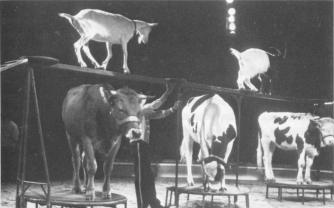
Fig. 59. A farrn animal act which was changed by the goats refusing to cross the plank when it was on the cattles back.
In another part of the act, a pig was meant to go on the see-saw with a bunch of geese on the other side. The pig would always jump enthusiastically on to the see-saw before the geese had fully prepared themselves on the other side. This frightened the geese and they ran off noisily. The act was changed so that the two pigs see-sawed together on one see-saw and the geese on another.
These examples show that, firstly, the presenter is not necessarily dominant; and also that the trainer must be sensitive to the animals responses to the situation.
The majority of animal acts are to some extent unpredictable - the animals may react differently on different days, in different places and with different audiences - they have moods. The art of the presenter is often to make what has happened look as if it was meant to happen. This does not, of course, only apply to animal acts but to all the acts in the circus.
The most educational and creative circus act might be described as one in which the animals have first of all - like a human artist or ballet dancer - been schooled thoroughly in the relevant techniques; such as various behaviours and movements. This basic training is then used in different ways by different individuals for the development of the act: the animals being encouraged to use their own initiative and possibly creativity and imagination to participate willingly and develop, to some extent, their own act. This can be encouraged by a sensitive trainer or presenter, good relationships between human and animals and cooperation.
We do not talk about good education of humans as demanding only obedience and domination but rather one in which the human is given the basic tools (which may require considerable application and motivation, hard work and obedience, too). Once these have been acquired, the human is encouraged to use them to develop his or her art and particular skills. Some end up great artists and dancers; some are mediocre. What makes a great performer, though, is not blind obedience and the domination of one individual by another, but imagination, sensitivity to each partaking individual and willing cooperation. How much greater our respect for all participants then becomes.
If we have yet to see this with animal acts in circuses, it is not that it cannot happen, it is just that it has not yet been thought about and efforts made to try it out.
f) The use of positive reinforcement
If this thesis has some basis we might expect to see some evidence of pleasure in the animals when they get things right; for example, when they are praised, they may even enjoy the process of learning as some humans do, finding the mind- stretching nature of appropriate and well-taught ring work exciting and rewarding in itself. Did we see any evidence of this?
All training sessions used positive reinforcement in the form of food rewards and praise with the voice. The food rewards varied from lumps of sugar, mints, lumps of meat, or a specially made biscuit called vitamins. The first important tenet in training is to find something that an animal will work for. This may simply be the trainers approval (word praises and scoldings were used persistently to encourage and discourage an animal at all stages of training), or initially some sought after small tit-bit. In some cases, I think we could consider the animals as enjoying their ring work, but we need to have much greater understanding of possible pleasure in animals. Usually, they worked enthusiastically for the rewards.
Another way of training animals (or humans) to perform certain tasks is by moulding. This is where the animal, or its appendage, is placed in the required position, and then the animal praised and positive reinforcement used. This is best done without force or any unpleasant stimulation. It was used successfully by the Gardiners in their work with teaching Amslan to the chimp Washoe [94].
3) Loss of dignity in performing animals
Another accusation is that animals performing in circuses is unnatural and undignified - the animals are made to look like stupid human beings and lose dignity thereby. The loss of dignity is probably in the eye of the beholder, if an animal finds a particular activity degrading, presumably it will either refuse to do it, or if coerced will show evidence of distress (Chapters 3 and 4). Since this will interfere with the training and performance, the usual thing to do is change the act for that individual. Certainly acts which humans find degrading may tend to decrease the humans respect for the animals themselves. On the other hand, representing animals as slightly handicapped humans elicits on occasion the ah reaction (Oh, how cute.) and thus care-giving behaviour from the human audience. Different humans will consider that this is either good or bad in terms of the benefit to the individual.
Let us consider the human judgement in more detail as, even if there is no evidence for loss of dignity by the animal, it does reflect what humans feel. The acts most humans find to be degrading and humiliating for animals are ones where, as a general rule:
a) the animal is made, they feel, to look like a human in one way or another - and in particular an inadequate or stupid human; e.g. the RSPCAs literature against circuses. In this case, the point is doubly made as the lion depicted is wearing a clowns or dunces cap and a thick nose.
b) the act is highly unnatural to the species.
From the educational point of view, this type of approach does not put across an acceptable or desirable image of animals. It tends to reinforce people in their belief in the homocentric attitudes of superiority. Far better would be to put across the idea of the animal as an intelligent, able and beautiful sentient individual; perhaps more intelligent, able and beautiful than we had previously supposed.
Some will argue that this is what television films do, and that it can only be done by displaying the natural behaviour of the animals. This is, I suggest, disputable.
First, let us examine if this is what television wildlife films do. The vast majority of television footage shown is not, as a casual viewer might suppose, the animal caught in the act as the camera operator happened to walk by. It is highly structured, often involving elaborate set-ups with sometimes live animals used as decoys or killed in order to make the footage. There are serious ethical arguments involving the use of animals in the television and film industry [113]. This is being changed by legislation so that at least animals do not suffer while they are filming. However, there is another serious disadvantage to assuming that wildlife films offer a sufficient education concerning animals. It is incorrect to assume that the television films are displaying the animals as they are. What is caught on film are the dramatic highlights of animal life, just as in human theatre. The result is that the observer may gather a completely incorrect idea of how animals live. The vast majority of the time the animals go about their lives with little melodrama, little obvious sign of the tooth and claw of wild nature that the television camera is so keen on capturing. This is not to say that nothing is going on in their lives, but rather that what is going on in their societies is less obvious and, in fact, may be completely unseen or not understood by those who are not skilled observers. For example, in the four years of living in the bush.of Africa studying antelope, I never once witnessed a chase and kill by a predator; although I did accumulate a great deal of information on the relationships between individuals, their ecology and many aspects of their behaviour. I have yet to see any television footage of gnu, gazelles or zebra in the Serengeti, for example, which does not include a hunt and kill by the large predators. Often, the footage is obtained by elaborate set-ups, both the predators and the prey being driven, manipulated and sometimes killed for the cameras.
Whether or not this is justified ethically is not my concern at this point. I am simply making the point that film footage does not usually display the normal natural behaviour of the animal. It shows only the melodramatic moments of it; also, it manipulates it by setting up situations. This is what human theatre and films do too. We should recognise that wildlife films are also theatre; that does not make them useless or invalid, however.
The film footage can never allow the direct experience of the animal and any interchange between the human and the animal. Indeed, it could be argued, that the display of animals in wildlife films often emphasises the differences of animals from humans. It might encourage some respect, impart some knowledge, but only in a sense as we would have for Martians as something quite alien and unrelated.
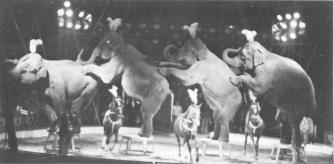
Fig. 60. Elephants dont stand on pedestals with horses running underneath them in the wild. Such an act is certainly unnatural in the sense that it does not occur in the wild, but is it undignified for the animal, or is this some humans perception of this act?
Another possibility is that presenting the animals as stupid human beings shows them in a way that exercises our compassion and responsibility to them - as we must respond to children or handicapped human beings. It is a question of whether we believe that compassion for the underdog, or respect for a highly intelligent and able other being, is most desirable in humans, and of most benefit to animals in the long run. The members of animal welfare organisations are often highly motivated towards the former; the latter would appear much more acceptable but often requires a rather new world view.
Circuses in Britain, in any case, have over the last few years become extremely sensitive to this criticism. I did not see a single act where animals were dressed up like humans.
4) Training is unnatural, therefore wrong
We did, however, see acts where the animals were taught to do behaviours that are not in their natural behavioural repertoire, although at least one trainer denied that this was the case, and that he had seen elephants in the wild standing up on their hind legs, reaching for things, or balancing on their front legs while drinking, and so on. This is no more absurd than the horse establishment, led by the classical Spanish Riding School, maintaining that all movements taught to horses in Dressage are natural movements and not tricks which is a demeaning term used fpr what circuses teach their animals.
There are two points that need examining here:
So not only is it debatable what we are going to define as natural but it is also debatable that only natural behaviour should be performed by animals in circuses, if what we are after is increasing humans respect, understanding and awareness of other animals as other intelligent, sentient, admirable beings.
There is the question of possible injury to the animal while performing some acts, and certainly it would be sensible to ensure that if an animal does fall, or something goes wrong with the act, it is unlikely to be seriously hurt. This is considered for human beings (e.g. by the provision of safety nets for trapeze artists) and should also be considered seriously for the animals.
Thus the dignity of the animal, and the wrongness of performing unnatural acts by both domestic and wild animals in circuses and zoos are difficult concepts to define. The performance of such acts from the animals point of view may not be such a bad thing.
It is true, however, that many humans find such acts displeasing. Is this not a matter of taste? I find plastic garden gnomes odious but I see no rational reason to ban others from having them, unless the having of them causes further problems (such as using up scarce resources of materials). However, at the same time, the having of them may be an indicator of other attitudes which I might think was undesirable or even ~ful. If this were the case one would perhaps, in a reasonable democracy, not ban garden gnomes, but rather by example and persuasion try and change peoples attitudes so they themselves change the plastic gnome into a beautiful garden scuplture. Changing circus acts in this direction would be possible.
The next question is: Are there any positive sides to the training and performing of circus animals? The RSPCA and others devoted to the total banning of circuses argue that in no way can they contribute to conservation, education or research, which are the usual arguments used by zoos to justify their existence. Is this true? Also, can the animals and humans benefit in any way from being trained, training or performing?
I think there are arguments to be made here, some of which are new:
As a rule, the training in circuses is professional; negative reinforcement was used infrequently and there were no indications of cruelty. What the animals were taught lacked innovation and imagination. The main criticism of the training was that there are very few real trainers in Britain (about six). Almost all the wild animal training is in the hands of one family. The other main criticism was that in British circuses at least there was not enough training being practised, and it was not innovative or always appropriate for the species.
Usually, the animals are trained by a trainer and then they are hired out to a circus; this may be anywhere in the world. Sometimes the animals will go with their groom or presenter to the circus; occasionally the circus proprietor will be the trainer and will keep and present the act; but more usually a presenter is hired who will spend a few weeks with the trainer learning how to present the act in front of the audience. The trainer trains the presenter. There must be a period of becoming mutually familiar for the animals and the presenter before they leave with the act. Some presenters were obviously very serious about their animals and took enormous pains and worked very long hours to iron out any problems before they left with the animals; others were slap-dash and were clearly in the business because of the dashing figure they could cut in the ring rather than their fundamental interest in the animals.
The trainers are usually strict about not letting presenters change the act or try to teach their animals other tricks. This is partly out of professional pride in their own act, but also because it is recognised that as a rule presenters do not have the know-how to train the animals properly and everything may go wrong if they try. Often trainers complain bitterly about the presenters when the animals return, usually on the grounds that the animals have got into bad habits which will take time to overcome.
The reason why the training (when it occurred) was so professional was probably that it is an extremely demanding, exacting, time- and patience-consuming job. Its skills are little recognised by the majority of people and it has little glamour attached, except among the small circle of other animal trainers and circus people. Thus anyone who was not seriously interested in the animals for their own sake would find much more glamorous and better paid jobs to do in the circus.
Anyone can become a circus trainer; usually, however, they are born into the circus and begin to learn to train and present animals almost before they can walk. It is possible to start as a groom, the bottom of the circus hierarchy, and gradually work up to be a presenter and then a trainer. Some people who wish to make the circus their life, after a period as a groom and/or presenter, will buy one or two animals, train them, and then try to get hired by a circus for a season.
It seemed that the personality of the trainer, their interest, skill and persistence, were much more important in their success than any tricks of the trade. Thus I found the trainers, in general, happy to talk about their methods and training schedules. However, they are very conscious of how easy it is to learn how to train. This does not mean that anyone will be able to do it but often grooms, having witnessed a few training sessions, will try to set themselves up as trainers. This is usually unsuccessful. It takes years of experience and dedication to become a good trainer. As a result, most circus trainers liked to cultivate a slight air of mystery about their job - but they were delighted to engage in hours of discussion about individual animals personalities.
There was great deal of repetition in what the animals were taught and what the acts consisted of. This may be partly because most trainers have learnt at their fathers knee, partly because of shortage of time available for training, partly lack of thought and partly the sometimes stultifying hold of tradition.
The trainer is, to a degree, caught in a double bind. The act must be innovative: the animals doing new and different things. At the same time, the circus must be traditional. It is assumed, probably wrongly, that people go to the circus because they know they will see the same sort of things, and the circus itself is proud of its traditions.
The act must also be spectacular. Often this can be achieved by elaborate props and presenters and sometimes animal costumes and harnesses, rather than sophisticated animal training. The difficult acts to train may well be less popular or less spectacular so there is not necessarily a force to progress and improve training, except from the trainers peers. The reverse is often the case - popular or spectacular acts may often be very easy to train.
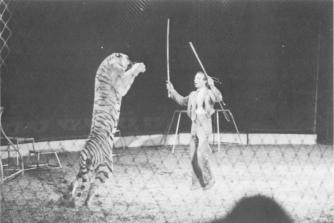
Fig. 61. A movement at least ressembling the attack of the tiger. Is this an appropriate act showing the abilities and skill of the tiger, and the rnutual trust between presenter and tiger, or does it simply show the trainers courage and machoism?
The trainer must have the animals do what the audience likes to see. If they like attack trained big cats (where the cats are trained to look as if they are attacking the presenter) they must train them so, even though the trainer may not like this representation of the cats. Audiences vary in what they like from culture to culture; for example, attack-trained cats go down well in the US and Southern Europe, but some Northern European audiences dont like them at all. It would be possible for the circus to change the publics attitude by, for example, presenting exciting acts enhancing the litheness, grace and affection of the cats, instead of their ferocity.
The trainer is near the top of the circus hierarchy: in part because of this, some are not very willing to learn; they are often bound by tradition, and may consider they know it all! The usual way to become a trainer is to be born into a circus proprietors family, although as mentioned, it is possible to work ones way up. The trainers are still very jealous about their skills. Training in the circus world (as well as outside it) is surrounded with secrets, mystic and magic. Trainers seem almost frightened that their secrets will out and then everyone will want to be a circus trainer once they realise that there are no secrets - it is simply hard work, experience and skill!
This is unfortunate and obviously not the case since very few people would be interested in putting in the time, dedication and patience to learn the skills (often under very difficult conditions) for the proper training of circus animals. One Swiss circus realised this, and has open, genuine training sessions for the public and always attract a group of devotees who sit all morning watching the slow training of the various animals for the next years acts, and come back the following year to see how they have progressed.
Over 90% of the circus audiences who returned our questionnaire wanted to see the animals being trained (Appendix 3). Open training sessions are vital if circuses are going to dispel the publics suspicion about cruelty, inappropriate training, and fulfil the role in educating the public about the amazing abilities of the animals, and the sophistication possible in inter-species communications. Unfortunately, it does not happen as a matter of daily routine in any British circus (although I have repeatedly suggested to them that they should have open training sessions). The closest that they have come is to have rehearsals of the trained or almost trained animals. They are, I think, unsure about allowing the public to see the training in case things do not always work well, which of course they do not; yet how it is sorted out when things go wrong is one of the most interesting aspects.
The other reason why circuses are loathe to have open training sessions is because there are very few trainers in Britain, and each circus does not have a trainer who is actively training and travelling with them. This is one of the major criticisms of British circuses: there is not enough training and not enough good trainers. Some acts remain the same year in year out and the benefits of training which I have mentioned are then certainly not fulfilled.
Conclusion
The field of animal handling and training is one where little serious thought on the ethics and ethological appropriateness of various systems has yet been devoted. This study of animal training in circuses suggests that some of the widely held beliefs concerning training are not necessarily correct; for example, evidence for serious or prolonged cruelty, suffering and distress in the animals during or as a result of the training in circuses was absent in the 200 hours I studied.
It is necessary to understand the importance of avoiding frightening animals in training (because it is then that they may well be dangerous). As a result, it is not surprising to find that positive reinforcement was used in the training of circus animals more widely and more frequently than negative reinforcement.
The other criticisms that animal welfare organisations have for animals trained for circuses are concerned with possible loss of natural dignity, by the performance of unnatural behaviour, and the idea that the only thing demonstrated by animal training is the domination of the animals by the humans. These concerns have been discussed briefly. There is no necessity to ensure domination; a more appropriate approach is one of cooperation. The trainer or educators job is to motivate the student/animal to learn. Positive reinforcement and emotional bonds between animals and human are usually more effective in achieving this. There are positive things that, provided the animals show no evidence of prolonged distress and are kept in ecologically and ethologically sound environments (see Chapter 9), animal training in circuses can contribute to our respect and understanding of other sentient beings. These positive things are:
a) captive animals should be able to be handled safely in order to reduce chances of suffering during normal routine management, including veterinary care;
b) training or educating the animal can act as a form of occupational therapy for animals, and they can apparently enjoy it;
c) the essence of circus training is that it concentrates on the individual, and respect for him or her, and allows direct experience of the individual;
d) the circus is the only place where many species are trained and it can increase the quality of life for both human and animal by allowing emotional bonds to develop;
e) provided the circus is presented appropriately, the audiences respect, interest and delight in all the animals can be enhanced;
f) the close individual association between animal and human inevitably leads to greater mutual knowledge and understanding;
g) circus animal acts, properly presented and appropriate for the species and individual, can enhance the respect, joy and wonder of the human observers. It can be an inter-species art form, demonstrating also the sophistication possible of inter-species communication, and the animals creativity and innovation.
It is thus concluded that there is no reason why circus training, any more than any other animal training, of its nature causes suffering and distress to the animals, or should be considered ethically unacceptable. There are bad circus trainers, just as there are bad teachers and bad parents, but this does not argue for the banning of circuses, any more than for schools or parenthood. However, there should be more appropriate acts trained to allow the animals to show their unique abilities and personalities and enhance human respect and admiration. There is a strong argument to establish a training school for all animal trainers and ensure that there is a well- qualified trainer travelling with each circus, and actively training the animals.
Properly done, the training of circus animals can, on balance, benefit both animals and humans, and lead to greater inter-species knowledge.
|
Any
non working links, comments or suggestions please contact the webmaster:
johneaston@diddly.co.uk |
|